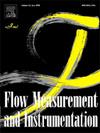解决粒子流测速仪方向模糊性的新技术
IF 2.3
3区 工程技术
Q2 ENGINEERING, MECHANICAL
引用次数: 0
摘要
本研究引入了一种新颖的条纹方向解析算法,用于确定具有多个条纹的单帧图像的流场方向。通过将条纹强度从条纹图像总强度的 100% 调整到 50%,来确定条纹方向。该技术主要应用于两种类型的流动:平行流和希尔涡流,平行流又分为恒速平行流和加速平行流两种类型。使用不同类型流动的目的是测试算法在简单和复杂流动中的稳健性。算法的性能通过真实速度矢量与最小平方拟合速度矢量之间的角度偏差进行检验。正确合成条纹方向的数量用成功率(百分比)来衡量。成功率高意味着角度偏差小,获得正确方向的速度矢量数量多。在这项研究中,考虑了四种不同的图像格式:DP(双精度)、16 位(无噪声)、16 位(1.0% 噪声)、16 位(5.0% 噪声)和 8 位(无噪声),DP 和 16 位图像格式的结果最好。平行流的结果表明,条纹方向的成功率为 100%,希尔涡是一种复杂流,因此,由于速度非常低(小于 0.1 px(像素)/间隔)和速度梯度非常高(大于 52 px/间隔),算法很难解析某些条纹方向。观测结果表明,希尔涡合成条纹图像的解析成功率为 92.76%,这意味着大部分合成条纹都得到了解析。还使用 PDMS 微通道装置进行了实验分析。用较长的相机曝光时间记录了强度变化条纹,为了保持强度变化,当 LED 打开时,开始最大照明,并在总照明强度的 50% 关闭时持续减少照明。最佳结果的成功率为 94%。因此,所提出的新方法可以用较便宜的硬件来处理单帧图像,并适用于多种应用。本文章由计算机程序翻译,如有差异,请以英文原文为准。
A novel technique to resolve directional ambiguity for Particle Streak Velocimetry
In this study, a novel streak direction-resolving algorithm is introduced to determine the direction of the flow field for a single image frame with multiple streaks. The streak direction was resolved by varying its intensity from 100 % to 50 % of the total intensity of the streak image. This technique was applied to two main types of flows parallel and Hill's vortex flows, parallel flows were divided into further two types constant velocity parallel flow and accelerating parallel flow. The purpose of using different types of flows was to test the robustness of the algorithm with easy and complex flows. The performance of the algorithm was checked by the angular deviation between the true and least-square fitted velocity vectors. The number of correct synthetic streak directions was measured with the success rate in percentage. A high success rate means low angular deviation and a high number of velocity vectors with correct direction was obtained. In this research, four different types of image formats were considered DP (double precision), 16-bit (without noise), 16-bit (1.0 % noise), 16-bit (5.0 % noise), and 8-bit (without noise) and the best results were obtained for DP and 16-bit image formats. The results of the parallel flows indicated a 100 % streak direction success rate, Hill's vortex was a type of complex flow therefore, the algorithm hard to resolve some streak directions due to very low velocities (less than 0.1 px (pixel)/interval) and very high-velocity gradients (greater than 52 px/interval). The observation shows that Hill's vortex synthetic streak images were resolved with a success rate of 92.76 % which means that the majority of the synthetic streaks were resolved. Experimental analysis was also done by using the PDMS microchannel setup. Intensity variation streaks were recorded with long camera exposure time and for maintaining the intensity variation, as the LED switched on maximum illumination was started, and continuous decrement in illumination was set by switching off at 50 % of the total illumination intensity. The best results were achieved with a 94 % success rate. Therefore, the proposed novel approach can be used with less expensive hardware for image processing with a single image frame and is useful for multiple applications.
求助全文
通过发布文献求助,成功后即可免费获取论文全文。
去求助
来源期刊

Flow Measurement and Instrumentation
工程技术-工程:机械
CiteScore
4.30
自引率
13.60%
发文量
123
审稿时长
6 months
期刊介绍:
Flow Measurement and Instrumentation is dedicated to disseminating the latest research results on all aspects of flow measurement, in both closed conduits and open channels. The design of flow measurement systems involves a wide variety of multidisciplinary activities including modelling the flow sensor, the fluid flow and the sensor/fluid interactions through the use of computation techniques; the development of advanced transducer systems and their associated signal processing and the laboratory and field assessment of the overall system under ideal and disturbed conditions.
FMI is the essential forum for critical information exchange, and contributions are particularly encouraged in the following areas of interest:
Modelling: the application of mathematical and computational modelling to the interaction of fluid dynamics with flowmeters, including flowmeter behaviour, improved flowmeter design and installation problems. Application of CAD/CAE techniques to flowmeter modelling are eligible.
Design and development: the detailed design of the flowmeter head and/or signal processing aspects of novel flowmeters. Emphasis is given to papers identifying new sensor configurations, multisensor flow measurement systems, non-intrusive flow metering techniques and the application of microelectronic techniques in smart or intelligent systems.
Calibration techniques: including descriptions of new or existing calibration facilities and techniques, calibration data from different flowmeter types, and calibration intercomparison data from different laboratories.
Installation effect data: dealing with the effects of non-ideal flow conditions on flowmeters. Papers combining a theoretical understanding of flowmeter behaviour with experimental work are particularly welcome.
 求助内容:
求助内容: 应助结果提醒方式:
应助结果提醒方式:


